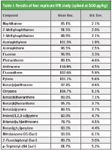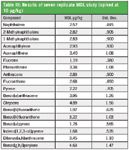Method for the Validation of PAHs in Soil and Sediment Samples Using Pressurized Liquid Extraction and Automated Cleanup
FMS Inc.
PAHs are a group of organic compounds consisting of two or more benzene rings and are often the byproduct of petroleum combustion. Due to their carcinogenic characteristics at relatively low concentrations, they are of particular environmental concern. Seven PAHs have been classified by the US EPA as probable human carcinogens and their toxic characteristics and persistent nature place them among the most extensively monitored organic contaminants.

Table I: Results of four replicate IPR study (spiked at 500 μg/kg)
The following procedure details the use of pressurized liquid extraction (PLE) in conjunction with automated silica gel cleanup (PowerPrep) to deliver a robust, efficient sample prep process for soils and sediments designated for PAH analysis. Outlined, are an initial precision and recovery study (IPR), a matrix detection level study (MDL), and a matrix validation of a NIST reference material.

Table II: Results of NIST 1944 analysis (reported in mg/kg)
Instrumentation and Consumables
- FMS, Inc. PLE System
- FMS, Inc. PowerPrep System
- FMS, Inc. SuperVap Concentrator System
- FMS, Inc. 50 mL direct-to-vial concentrator tubes
- FMS, Inc. 200 mL concentrator tubes (1 mL termination)
- Thermo Scientific Trace Ultra GC with DSQ MS
Consumables
- FMS, Inc. 6 g neutral silica columns
- Fisher Pesticide Optima* n-Hexane
- Fisher Pesticide Optima* Methylene Chloride
- Agilent Hydromatrix©
- NIST 1944 RM; NJ River Sediment
- Restek PAH Mixture (Cat# 31841)
- Restek Surrogate Mixture (Cat# 31062)
- Restek SV Internal Standard Mixture (Cat# 31006)
Procedure
Sample Prep
Samples are weighed out in glass beakers.
For IPR and MDL samples, 20 g of baked Ottawa sand was used.
Sample portions are spiked with surrogate solutions and/or PAH spiking solution.
Samples are generously mixed with Hydromatrix.
Dried samples are transferred to 40 mL PLE extractions cells.

Table III: Results of seven replicate MDL study (spiked at 10 μg/kg)
Pressurized Liquid Extraction System
1. Cells filled with hexane: DCM (50:50)
2. Cells pressurized to 1500 PSI
3. Cells heated to 120 °C for 20 min
4. Cells cooled to ambient temperature
5. Cells flushed with 20 mL solvent
6. Cells purged with N2 and extract discharged to SuperVap Concentrator
SuperVap Concentration System
Preheat temp: 20 min at 60 °C
Evaporation mode w/Sensor temp: 60 °C
Nitrogen Pressure: 10 PSI
PowerPrep System
1. Condition column(s) w/10 mL DCM
2. Exchange column(s) to hexane
3. Load sample extract(s)
4. Flush column(s) w/10 mL hexane
5. Elute column(s) w/35 mL DCM
6. Extract eluted to 50 mL SuperVap concentrator tubes with Direct-to-GC vial connection.
Conclusions
Following the extraction and cleanup with silica gel, the extracts were analyzed on a Thermo Scientific Trace GC with DSQ Mass Spectrometer. All analysis was performed in the selective ionization mode (SIM), with one quantitation ion and one confirmation ion monitored.

Figure 1: Ion spectra for benzo[a]anthracene from analysis of NIST 1944, showing resolution from chrysene.
Analysis of the extracts showed excellent extraction efficiencies for all compounds analyzed, with minimal deviation between runs. The high level of efficiency enabled the establishment of an MDL below the target of 5 μg/kg for all analytes using the designated sample size. The calculated concentrations for the NIST 1944 sample were between 70–130% for all analytes, thus validating the PLE system extraction for soil and sediment sample. Due to the wide array of other organic contaminants present in the NIST reference sample, the efficiency of the 6 g silica column was further validated by the clear resolution of each target analyte.

Figure 2: Total ion chromatogram from NIST 1944 analysis.
Using the FMS Pressurized Liquid Extraction system in conjunction with the PowerPrep Sample Cleanup system demonstrates an efficient and robust sample prep method that delivers both high quality results and increased sample throughput. By combining extraction, concentration, and cleanup with direct-to-GC-vial concentration, this automated sample-to-vial process frees laboratory staff to perform other tasks which increases the lab's throughput, quality, and consistency of results.
FMS Inc.
580 Pleasant Street, Watertown, MA 02472
tel. (617) 393-2396, fax (617) 393-0194
Website: www.fmsenvironmental.com

Separation of Ultra-Short and Long Chain PFAS Compounds Using a Positive Charge Surface Column
December 11th 2024A separation of ultra-short and long chain PFAS (C1-C18) is performed on a HALO®PCS Phenyl-Hexyl column along with a HALO®PFAS Delay column which demonstrates excellent retention for both hydrophilic and hydrophobic analytes.















